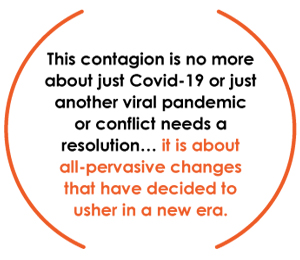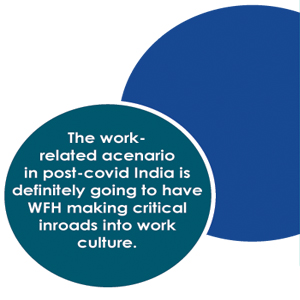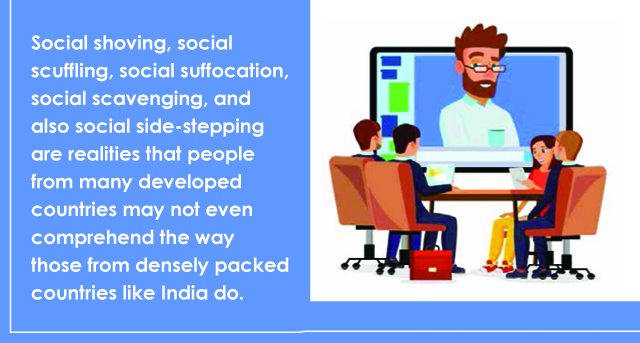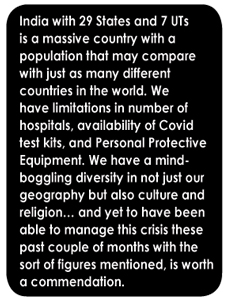
Delhi10:37 AM | 28th April 2024
There are definitely going to be changes in the way the countries of the world perceive each other, the way we look at each other, the way education is going to head and the way job profiles may change.

From learning to earning, from survival to career, from passion in relationships to passion in professions, from choices one wants to choices that exist, from what was to what is… this pandemic has the power to roll over and transform entire lifestyle landscapes, conceptual environment, and everything else as we have known or experienced. That the post-covid world is going to be different, is obvious. What remains a conjecture is the manner in which change is going to express itself. There are definitely going to be changes in the way the countries of the world perceive each other, the way we look at each other, the way education is going to head and the way job profiles may change.
Some of these changes have already begun to get clear, for instance, the role of armed forces may get broader if we consider the way the three arms were directed towards the expression of gratitude to covid warriors. The mainstream media has been constantly heckled for either being hopelessly propping up the lost cause of literate leftist liberals or being in a down-in-the-dumps sycophantic mode. We have been seeing how news reporting has been a blatant attempt to paint words on hoarding and placards, so to say and it is no surprise to find a lot of people calling it the lame-stream media. Is it time for the spread of real news to become the privileged option for the online world? Only time will tell… but a change is definitely on and any form of media that survives will be the one that shapes up.
So yes, this contagion is no more about just Covid-19 or just another viral pandemic or conflict needs a resolution… it is about all-pervasive changes that have decided to usher in a new era.

This is an age of contagion
Adam Kucharski in his book ‘The rules of Contagion’ writes that a contagion is about why things spread and why they stop. He also points out that mathematics and models can be used to study contagious events. The book also points out that the word contagion can be applied in many ways… and this includes finances. The word ‘financial contagion’ has existed since the mid-nineties and the concept got a deeper and firmer footing during the 2008 financial crisis. Besides finances, contagion is connected to other diverse facets like violence and crime, ideas and internet memes, online content, community, and even lifestyle. An epidemiologist Gary Slutkin compared the maps of killings in the US, violence in Rwanda, and cholera outbreaks in Bangladesh and found that the cluster-and-outward-spread logic was common to them all. A Yale sociologist found that the statistics of shootings in Canada showed clearly that ‘for every 100 people who were shot, contagion would result in 63 follow-up attacks.’ It is these kind of studies that led to the creation of R or reproduction number. It is these mathematical conclusions that are equally valid during the corona virus pandemic.

One solution to the violence contagion problems forwarded by sociologists and epidemiologists is sending in a team of ‘violence interrupters’ who use techniques like counselling victims, their friends and family to walk away from violent retaliation. This is the sort of solution that helps in the case of the present covid pandemic as well. Thus the mitigation of any contagion needs not only an in-depth analysis of reliable data but also the role of new technologies interacting with human behavior as we have seen when para-medical teams enter hot-spots to not just talk about testing everyone in the zone but also isolating the patient and the need for others to go into a self-quarantine period. This is the sort of scientific breakthrough that may play a major role in tackling any future outbreaks like the one we are facing now.

India vs other countries, statistically speaking
It was in 1883 that Ronald Ross, a British surgeon, collected enough data to suggest that it took 48,000 mosquitoes to result in an average of one new human infection… and his conclusion was that removing or treating stagnant water would thus have a direct effect on the spread of infection. Thus rate of infection and rate of recovery matter just as much as steps taken to break the spread.If we compare this data, it is easily deduced that so far as strategic conflict resolution is concerned, India has been performing rather well so far. If the trend continues, the post-covid era may see India climbing a few notches up in the arena of political will and administrative strategic as well as tactical handling of a conflict. If this is equated to being a sort of world war, India is definitely leading the victory march.

The pan-India Covid-19 related figures, as on the 5th of May 2020, according to the statistics mentioned on Arogya app point to 46,433 infected cases, 12,727 recovered and 1,568 deceased. More than a million tests have been conducted over all the states so far.
| State | Population | Infected cases | Recovered | Deaths |
| Maharashtra | 11.42 crore | 46,433 | 2,465 | 583 |
| Gujarat | 6.27 crore | 5,804 | 1,195 | 319 |
| Delhi | 4.61 crore (NCR) | 4,898 | 1,431 | 64 |
| Madhya Pradesh | 7.33 crore | 2,942 | 798 | 165 |
| Rajasthan | 6.89 crore | 3,061 | 1,394 | 77 |
| TamilNadu | 6.79 crore | 3,550 | 1,409 | 31 |
| Uttar Pradesh | 20.42 crore | 2,766 | 802 | 50 |
Let me compare these seven states of India with a country with the nearest population. Mexico has a population of 11.42 crore against 12.62 crores of Maharashtra and has 23,471 confirmed cases, 13,447 recovered, and 2,154 deceased. Gujarat with a population of 6.27 crore can be compared to South Africa with 5.78 crore which has 7,220 confirmed cases, 2,746 recovered, and 138 deaths. France with 6.7 crore vs Madhya Pradesh with 7.33 crore has a much serious condition with 1,32.000 confirmed cases, 51,371 recovered, and 25,201 deaths. UK with 1,91,000 confirmed cases and 28,734 deceased has a population of 6.89 crore as against 6.66 crore of Rajasthan. Brazil with a population of 20.95 crore has 1,08,000 confirmed cases, 45,815 recovered, and 7,343 deceased and the Indian state that comes nearest in population is Uttar Pradesh with 20.42 crore. Turkey with a population of 8.2 crore is comparable in population with Tamil Nadu with 6.79 crore and has 1,28,000 confirmed cases, 68,166 recovered, and 3,461 deaths.
The purpose for this comparison is that India with 29 States and 7 UTs is a massive country with a population that may compare with just as many different countries in the world. We have limitations in number of hospitals, availability of Covid test kits, and Personal Protective Equipment. We have a mind-boggling diversity in not just our geography but also culture and religion… and yet to have been able to manage this crisis these past couple of months with the sort of figures mentioned, is worth a commendation.
Transformation of post-covid social habits
The population density of India is 424 people persq km which is actually 29,500 people per sq km in Delhi. Now even if Netherlands is India’s neighbor on the global population index and has 464 people per sq km, this figure seems angelic when we are talking about social distancing if only urban areas are considered.

Social shoving, social scuffling, social suffocation, social scavenging, and also social side-stepping are realities that people from many developed countries may not even comprehend the way those from densely packed countries like India do. I remember discussing poverty with a bank executive in York more than twenty years back and what she said, surprised me. She said: ‘We lived in the poorer quarters of my city. I had to share my room with my brother.’

I can only imagine why social distancing appears like a somewhat surreal canvas of a corner of this world where some people gallop through only when equipped with rolls of toilet paper and cartons of mineral water. So far as India is concerned, space considerations are directly proportional to the way we go about managing our daily needs. Denser areas have more individuals queuing up for smaller portions and thus the frequency and intensity of violations of social distancing is larger.
If it is correct that adversity is a harsh but great teacher, a post-covid India must see a 360 degree transformation in social habits which include social distancing. For a country of the size of India, an ongoing process of surveillance and evaluation, though difficult, is an essential task that will catalyse this change. If achieved, this one factor will create a formidable impact in the area of governance.

Preventing people from going in the wrong direction
Any conflict is ultimately a battle between a pessimist and an optimist. Battles like the one that we are currently fighting against the Corona virus is fought in the mind. Yes, there are hospitals, quarantine wards, doctors, and other para-medical staff doing their work… but the population of a country the size of India will have trouble built into it. Imagine what happens if people do not have enough options and incentives to stay at home and follow the norms of social distancing… imagine the chaos if bored and anxiety-burdened psyches decide to rush out. Yes, it is the responsibility of the government to take care of jobs, finances, food, and safety and there are steps that are already being considered and will be implemented. Meanwhile, it is the individuals who must take care to contribute in a positive way.
Let me also add here that an article in HBR Ascend clarifies that so far as the definition of ‘contagion’ is concerned, even ‘feelings are more contagious in person, they can still be transmitted online — and by email, phone, or any other ongoing remote interaction with other people. In fact, isolation can increase social loneliness, which can dampen our mood, making us even more susceptible to negative emotional contagion. Given this, we can all benefit from becoming more aware of how we respond to emotional contagion during this time, even if we’re working at home.’
This is the reason why the social media today has an overdrive of people drawing, sketching, reading, writing, cooking, and so many other things. Equally true is the fact that a large number of people don’t read and do not draw or sketch or paint. The pessimist sees people just sitting and forwarding messages that make no sense at all. Many, according to the pessimist, are busy pushing whatever it is that they wish to push – ideas, books, products that don’t sell otherwise, and even their own below-average talents. Then there are those who sit and worry… or those who are unfortunate enough to be willing to be led to do something as foolish as trying to walk hundreds of miles away from wherever they are. There are many who are busy milking a crisis… by words or actions that have all the vile ideas that were born to mislead. The pessimist hisses: ‘Who is healing? Earth? Fewer people driving around is only a small part that most see and is probably insignificant to be initiating any healing at all. I don’t see even hope making inroads because hopelessness is fast overwhelming everything else.’ What matters in such times is positivity and more and more individuals who choose to be optimists.
WFH status in the post-covid world
It is wiser than a virus, keeps the economy happy, gives impulse-driven relaxation a chance, makes bosses seem like horned dudes who can only be heard barking out insane instructions, keeps organisations trim, makes catnaps possible… and allows us to go to work in pyjamas. You’ve got it if you murmured WFH.
Work-From-Home is going to strike humanity with full force once we’re done dealing with Corona. Companies have obviously begun to realise that employee clutter can be immensely contained and offices kept for more important strategic wine and cheese get-togethers without having the compulsion to entertain even the riff-raff. CTCs can be reined-in, maintaining office space can become less bothersome, and online monitoring will cause lesser headaches to HR.

I believe a lot of companies might already have realised that Corona has actually introduced WFH without expensive workshops, training sessions in exotic locations, and without having to deal with a barrage of protest-dipped questions that make no sense at all.
Employees, on the other hand, have probably realised that the romanticism linked to WFH was, in reality, just a play of words. Fiction. A lot of friends have told me that WFH is a pain… in more than one way.
However, the work-related acenario in post-covid India is definitely going to have WFH making critical inroads into work culture.
Post-covid plans for education
Students in India are as excited and as nervous as teachers are during the learn-from-home phase going on. This is because in a country where a large percent of both school as well as higher education is propped on subsidies, online communication hasn’t really been the norm yet. The covid outbreak led to this intense phase where everyone concerned (and this also includes administrators and managements) had to bring on the online alternative with no past experience in any of its modalities.
For education to go online it is both teachers and students who need to be there and exude confidence. Statistics point out that India has a billion phone connections with 87 percent being pre-paid which simply means that money invested in telephony is on a need basis. The country has 67 percent with a reasonable 3G or 4G internet connection and around 13 percent households have laptops or PCs. What is more interesting is the 10:40:40:10 ratio of technology grading which means 10 percent belong to the privileged class with home access to broadband through multiple devices, 40 percent have internet through mobile another 40 percent have mobiles without internet, and the remaining 10 percent have neither access to mobile nor internet. What also needs to be considered is that neither access to the hardware nor internet can be a guarantee of comfort with online learning.

What is surprising is the way both teachers and students accepted this challenge and within days we have reports of even tier 2 and tier 3 towns loving the concept of education through hastily but painstakingly shot home-videos. Applications from Zoom to platforms on Google and Microsoft and even other smaller and relatively unknown apps have been used for online learning extensively. We are a nation where notes and study material are quite literally creating their own hungama online. E-learning, webinars, classes on whatsapp, zoom sessions, Google docs, and even podcasts are a part of the new subset of terminology that have been adopted by the education sector in India. This sector, by the way is massive with nearly 1.5 million schools and colleges. Besides a new aura of comfort with online communication of even the more complex facets of education, another vital post-covid development is going to be the proliferation of regional language online interaction for learning. A report by Google India and KPMG confirms that nearly 73% of the Indian internet users are going to interact in a regional language by 2021. The vernacular approach has even earlier attempted to make inroads but the impact has always been doubtful. A post-covid India is also going to see this rise in vernacular power finally ‘bridging the country’s digital divide’.
Confidence
The single word that matters today is confidence. Every step that the government has taken to counter the pandemic has been full of confidence without the negativity associated with arrogance. It is this simple form of confidence that is going to lead us into a renewed India in the post-covid era where a transformed reality is going to be accepted by us all.
Copyright© educationpost.in 2024 All Rights Reserved.
